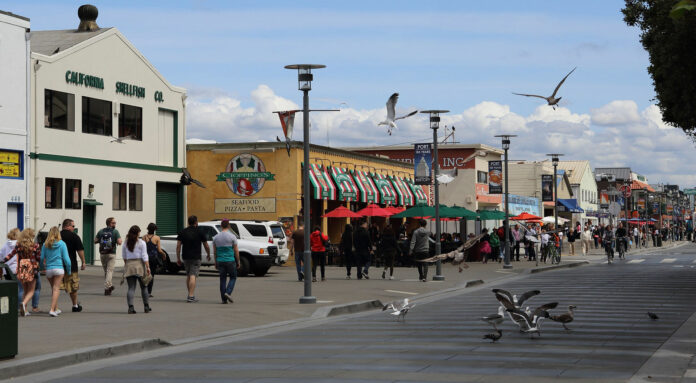MONTEREY COUNTY — Tourism, the No. 2 economic driver in Monterey County and the top driver on the Monterey Peninsula, saw a rise in 2022 that closed in on pre-pandemic figures of 2019.
While the tourism rebound has been significant, Monterey County Convention and Visitors Bureau (MCCVB) strikes a hopeful yet cautious tone as summer approaches.
The current outlook for the forthcoming season is uncertain as the destination feels residual effects from the severe January and March storms. More work remains to recover to pre-pandemic levels, and MCCVB remains aggressive with its marketing tactics laid out in its Long-Term Strategic Roadmap.
“We wouldn’t be doing as well as we are without the smart yet aggressive approach we’ve taken throughout the pandemic,” said Rob O’Keefe, president and CEO of MCCVB. “And, we won’t fully reach our tourism economy’s potential if we don’t maintain our managed growth strategy in the coming years.”
The annual Tourism Impacts report, prepared by Dean Runyan Associates, was recently released providing a look back at the calendar year 2022. Generally positive for all parts of the Golden State including Monterey County, however, some sectors of the tourism economy have a way to go.
The 2022 hotel revenue significantly surpassed 2019, yet restaurant spending is significantly below pre-pandemic levels. This suggests that the destination’s visitor mix remains out of balance with an over-reliance on drive market visitors who are known to bring their food and beverage and spend less in restaurants. It’s a challenge MCCVB had forecast and is managing within its Long-Term Strategic Roadmap.
“MCCVB led the development of the destination’s first-ever long-term strategic plan in 2022 that included all stakeholders in the tourism economy, from hospitality businesses to residents and elected officials,” said Teri Owens, general manager of Embassy Suites Monterey Bay and chair of MCCVB’s Board of Directors. “The goal is to come back better than we were before. While we’re making terrific progress, the recently released numbers show where we need to focus.”
A key strategy within the Long-Term Strategic Roadmap is to target fly-in visitors more aggressively who typically stay longer, do more and spend more. MCCVB conducted a study in 2022 from Tourism Economics that showed fly-in visitors average $1,364 spend-per-trip compared to drive-market at $959; part of the difference is restaurant spending.
“The drive market will always be our foundation, but we have an opportunity to reset the balance with growth in fly-in markets,” O’Keefe said. “Our goal isn’t more people, it is a better balance in the visitor mix.”
MCCVB analysis showed that Monterey County could significantly increase visitor spend without significantly increasing visitor volume and extended stays are key to that strategy. Extending the average by only one more night could increase incremental spending by nearly $900 million.
According to the report, in 2022 Monterey County saw nearly $3 billion in travel spending, a 5.5% decrease from 2019. Visitor spending in the destination supported 25,370 jobs (a 16% increase from 2021) and generated $307 million in state and local tax revenue that supports infrastructure improvements, first responder and emergency services, and other programs and projects that benefit residents of the community.
The immediate outlook
In the first quarter of 2023, Monterey County experienced setbacks that included severe storms in the first quarter of the year causing a two-fold economic impact. First, January through March travel levels were below 2022. Secondly, the extensive snowfall in the Sierra Nevada range is expected to lengthen the ski season into July creating further competitive pressure.
“While there was positive momentum of hospitality business throughout the destination in 2022, our marketing programs have been ramped up last quarter to support the recovery of recent storms,” O’Keefe said. “We still have a way to go to reach 2019 levels with a slow return of group, international and business travelers who add immensely to our economic vitality.”
Group and meetings hotel revenue spending in Monterey County are up 47% in 2023 year-over-year. International visitors from Canada, Mexico and parts of Europe are returning to California; however, high-value markets in Asia lag behind in recovery.
Group and international visitor travel sectors tend to stay longer, spend significantly more and create less congestion on our roadways, making a larger impact on the local economy, particularly during the times of the year when leisure travel is softer.
Monterey County’s competitive set — Napa Valley, San Luis Obispo County, Tahoe and Santa Barbara — is working to amplify demand for their destinations as they head into summer. Keeping Monterey County competitive, MCCVB and its Board of Directors continue its aggressive strategies laid out in the Long-Term Strategic Roadmap to ensure the destination thrives this year and well into the future.
“Monterey County is breathtakingly beautiful and inspiring, but we recognize travelers have many choices,” said O’Keefe, adding, “The competitive landscape is evolving and increasing.”
To learn more about Monterey County CVB and tourism’s economic impact on the County, visit SeeMonterey.com.















